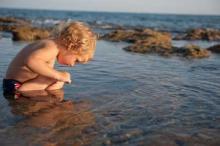
Interactive play environments involve a combination of elements that interact with each other as children play. Natural materials, such as sand and water, allow for hands-on, active manipulation that enhances learning as well as the play experience.1 Playing outdoors offers a rich variety of play opportunities with natural elements, such as plants, trees, flowers, dirt, mud, animals, and insects. In these rich environments, child’s play involves the whole child combining gross motor skills, fine motor skills, senses, emotion, intellect, individual growth, and social interaction.2
Playing outdoors is one of the things that characterize childhood, giving children the opportunity to explore, discover, practice, wonder, change, create, and learn about the world around them. Children’s basic needs for freedom, adventure, risk-taking, experimentation, and just being children are enhanced by outdoor environments.3
Children learn best through free play and discovery that is spontaneous, self-motivated, imaginative, active, pleasurable, and free of adult-imposed rules. The sensory experiences of outdoor play are different from indoor play. Children have greater opportunities to engage in messy activities as they interact with the environment, and they are given more freedom to be loud and active outdoors. Positive interaction with nature develops a child’s sense of wonder that fosters lifelong learning.4
There are many benefits for children who regularly interact in natural environments. Children’s cognitive development is enhanced by increasing their awareness, observational, and reasoning skills. Studies have shown they are more resistant to stress; have lower incidence of behavioral disorders, anxiety, and depression; and have a higher measure of self-worth. Children score higher on tests of concentration and self-discipline. They show more advanced motor fitness, including coordination, balance, and agility. Their play is more diverse with more imaginative and creative play that fosters language and social skills.5
Past generations had endless opportunities to play freely outside exploring the natural world with little or no restriction or supervision. However, today, children’s lives are much more structured and supervised with fewer opportunities for free play, especially outdoors.6 Naturalized playgrounds and discovery play gardens are being designed to offer a play setting with natural elements, landscaping, and vegetation. They offer a sense of wildness that stimulate learning, exploration, and experimentation. Loose parts, sand, water, and other naturally found objects are available for infinite play possibilities that encourage learning as children interact with them. Children can be inventive and creative in manipulating many natural materials, which gives them insight into the rules and principles that make the world operate. These open-ended play spaces stimulate children’s senses, nurture their curiosity, and allow them to interact with other children and adults as they discover the world around them. They also offer inclusive play for children with special needs allowing accessibility to all in a natural setting.7
- 1. Frost, Joe L., Pei-San Brown, John A. Sutterby, Candra D. Thornton. The Developmental Benefits of Playgrounds Olney, MD: Association for Childhood Education International, 2004. p. 206.
- 2. White, Randy and Vicki Stoecklin. “Children’s Outdoor Play & Learning Environments: Returning to Nature.” White Hutchinson Leisure & Learning Group. < http://www.whitehutchinson.com/children/articles/outdoor.shtml > 3 Nov. 2010.
- 3. “Outdoor Play.” Community Playthings. < http://www.communityplaythings.com/resources/articles/outdoorplay/outdoorplay.html > 01 Sept. 2010.
- 4. Op. cit., White Stoecklin.
- 5. Smith, Leon. “Research on Nature, Children, and Play.” Planet Earth Playscapes. < http://www.planetearthplayscapes.com > 02 Sept. 2010.
- 6. Op. cit., White, Stoecklin.
- 7. Op. cit., White, Stoecklin.

